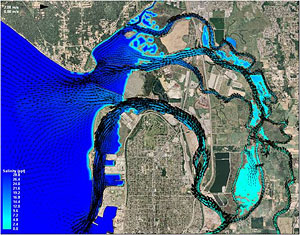SSM Habitat Restoration: Snohomish River
Hydrodynamic Modeling of Snohomish River Restoration Projects, Washington

The Snohomish River estuary is the second largest river discharge into Puget Sound and accounts for about 30% of the freshwater discharge to Whidbey Basin. The Snohomish River also delivers a large amount of sediment load to the Snohomish River estuary, which has resulted in a major mudflat region near the river mouth. The lower Snohomish River morphology consists of a number of braided sloughs that are an important habitat for juvenile salmon rearing before they migrate from freshwater to the saltwater environment. However, in the past century, increasing land development for agriculture and pastureland use has resulted in significant loss of wetland and marine habitat. The Tulalip Tribes of Washington State and Tribal Partners, including the National Oceanic and Atmospheric Administration, U.S. Fish and Wildlife Service, and Washington State Department of Ecology, initiated the Qwuloolt Marsh Hydrodynamic Modeling Study to evaluate the potential for restoring approximately 360 acres of habitat for migrating salmonids near Ebey Slough of the Snohomish River. Along with the Qwuloolt marsh project, three other restoration projects (Smith Island, Union Slough, and Biringer Farm) have been proposed near the mouth of the Snohomish River along the shores of Steamboat Slough and Union Slough. The total restored area as a result of these projects would be 1275 acres.
Battelle developed a three-dimensional high-resolution unstructured hydrodynamic model for the Snohomish River Estuary to evaluate the performance and efficiency of three restoration projects in the Snohomish River estuary delta. The model was calibrated with field data for a 14-day period specifically collected for this study. The calibrated model was applied to simulate the changes in hydrodynamics, morphology, and marine habitat conditions under the influence of restoration projects, individually and cumulatively.
Project Highlights
- Model results demonstrate that each individual project site can be successfully restored to tidally functioning estuary or wetlands with the proposed configuration.
- The restoration projects in the lower Snohomish River would result in increased tidal flows toward the river in the main river channel and all distributary sloughs.
- Model results also indicate that when all restoration projects are considered simultaneously, there is a cumulative effect on the river hydrodynamics and the river morphology.
Contacts and Project Team
- PNNL: Tarang Khangaonkar (CO-PI), Zhaoqing Yang (CO-PI)
- Tulalip Tribes: Kurt Nelson (PI), Maria Calvi (CO-PI)
Study Reports and Publications
Yang Z and T Khangaonkar. 2007. Hydrodynamic Modeling Study of the Snohomish River Estuary: Snohomish River Estuary Restoration Feasibility Study. PNWD-3864, prepared for Tulalip Tribes by Battelle, Pacific Northwest Division, Richland, WA.
Yang Z, T Khangaonkar, M Calvi, K Nelson. 2010. Simulation of cumulative effects of nearshore restoration projects on estuarine hydrodynamics. Ecological Modelling, 221(7):969-977. doi: 10.1016/j.ecolmodel.2008.12.006.